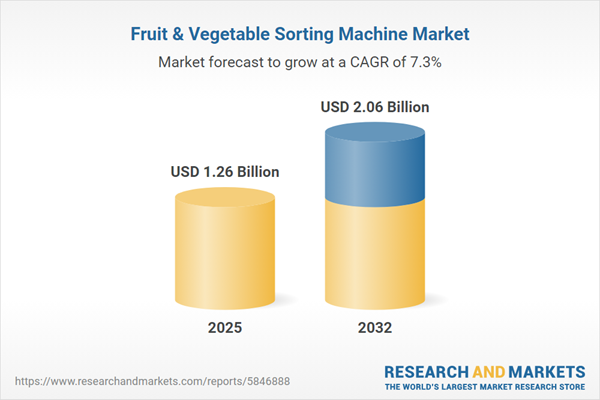Speak directly to the analyst to clarify any post sales queries you may have.
The Fruit & Vegetable Sorting Machine Market is experiencing robust transformation, propelled by shifts in global supply chains, rapid automation, and heightened quality demands. Senior stakeholders in agribusiness, food processing, and retail are evaluating technology investments to maximize throughput, consistency, and adaptability in a competitive environment.
Market Snapshot: Growth in Fruit & Vegetable Sorting Machine Market
The global fruit and vegetable sorting machine market grew from USD 1.17 billion in 2024 to USD 1.26 billion in 2025 and is projected to reach USD 2.06 billion by 2032, achieving a CAGR of 7.30%. Advances in equipment intelligence and efficiency are shaping new standards for fresh produce sorting and handling, supporting both scale and specialization in key regions worldwide.
Comprehensive Scope & Segmentation
This research provides in-depth analysis of the fruit and vegetable sorting technology sector through extensive segmentation by product, function, channel, end user, and geography.
- Machine Types: Automatic (including fully automatic and semi automatic units), Manual solutions.
- Sorting Techniques: Color-based sorting, shape recognition, size grading, and weight calibration solutions.
- Distribution Channels: Offline procurement via traditional distributors and demonstration events, Online platforms for direct ordering and comparisons.
- End Users: Agricultural farms adopting automation, food processors integrating high-speed lines, and retailers experimenting with compact in-store units for added value and transparency.
- Regional Coverage: Americas (North America, Latin America, including key markets such as United States, Canada, Brazil, Argentina), Europe, Middle East & Africa (Europe, Middle East, Africa with specific focus on countries like Germany, United Kingdom, UAE, South Africa, Nigeria), Asia-Pacific (China, India, Japan, Australia, among others).
- Notable Companies Analyzed: TOMRA Systems ASA, Key Technology, Bühler AG, Satake Corporation, GREEFA B.V., Compac Sorting Equipment Ltd, Moba Group B.V., Aweta B.V., Anliker AG, MultiSort Elektronik GmbH & Co. KG.
Key Takeaways for Decision-Makers
- Rapid adoption of artificial intelligence and advanced sensor solutions is setting new benchmarks for postharvest automation, significantly increasing sorting speed and accuracy.
- Collaborative Robotics, equipped with soft grippers and dynamic vision systems, now support gentle product handling and higher throughput, bridging gaps between manual labor and high-speed production.
- Cloud-based analytics deliver real-time performance data, empowering operators to optimize parameters and proactively address equipment maintenance, driving process efficiency and resilience.
- Trade environment shifts are prompting manufacturers and buyers to rethink sourcing, assembly, and investment strategies to maintain agility and cost-effectiveness under new tariff regimes.
- Regional adaptation is growing in importance, as customization of machine configurations and services becomes necessary to meet diverse operational and regulatory requirements.
Tariff Impact on Global Equipment Procurement
Recent tariff changes have introduced complexity for producers and suppliers by increasing duties on essential sorting machine components. As a result, companies are diversifying their sourcing networks, supporting local assembly, and emphasizing total cost of ownership—moving beyond initial capital outlay to long-term value and risk mitigation. These adaptations are fostering increased supply chain resilience while supporting ongoing sector growth.
Methodology & Data Sources
This research uses a robust mixed-method approach. Primary insights derive from qualitative interviews with manufacturers and food industry experts, balanced by quantitative triangulation of supplier data, independent field results, and certified industry publications. Rigorous cross-validation and trend analysis ensure market projections reflect real operational and policy drivers.
Why This Report Matters
- Enables executives to benchmark automation adoption, technology upgrades, and procurement strategies against current global best practices in fruit and vegetable sorting.
- Facilitates risk and opportunity analysis in response to trade policy shifts, evolving supply chain structures, and growth in demand for premium and organic produce standards.
- Empowers stakeholders to identify specific regional opportunities and optimal technology partners to enhance competitive edge and long-term operational efficiency.
Conclusion
With continuous innovation in digital sorting systems, advanced analytics, and regional adaptation, the Fruit & Vegetable Sorting Machine Market offers strong potential for stakeholders focused on quality, efficiency, and resilience. Understanding these strategic dimensions is vital for navigating the sector’s next phase of growth.
Additional Product Information:
- Purchase of this report includes 1 year online access with quarterly updates.
- This report can be updated on request. Please contact our Customer Experience team using the Ask a Question widget on our website.
Table of Contents
3. Executive Summary
4. Market Overview
7. Cumulative Impact of Artificial Intelligence 2025
Companies Mentioned
The companies profiled in this Fruit & Vegetable Sorting Machine market report include:- TOMRA Systems ASA
- Key Technology, Inc.
- Bühler AG
- Satake Corporation
- GREEFA B.V.
- Compac Sorting Equipment Ltd
- Moba Group B.V.
- Aweta B.V.
- Anliker AG
- MultiSort Elektronik GmbH & Co. KG
Table Information
| Report Attribute | Details |
|---|---|
| No. of Pages | 180 |
| Published | October 2025 |
| Forecast Period | 2025 - 2032 |
| Estimated Market Value ( USD | $ 1.26 Billion |
| Forecasted Market Value ( USD | $ 2.06 Billion |
| Compound Annual Growth Rate | 7.3% |
| Regions Covered | Global |
| No. of Companies Mentioned | 11 |









